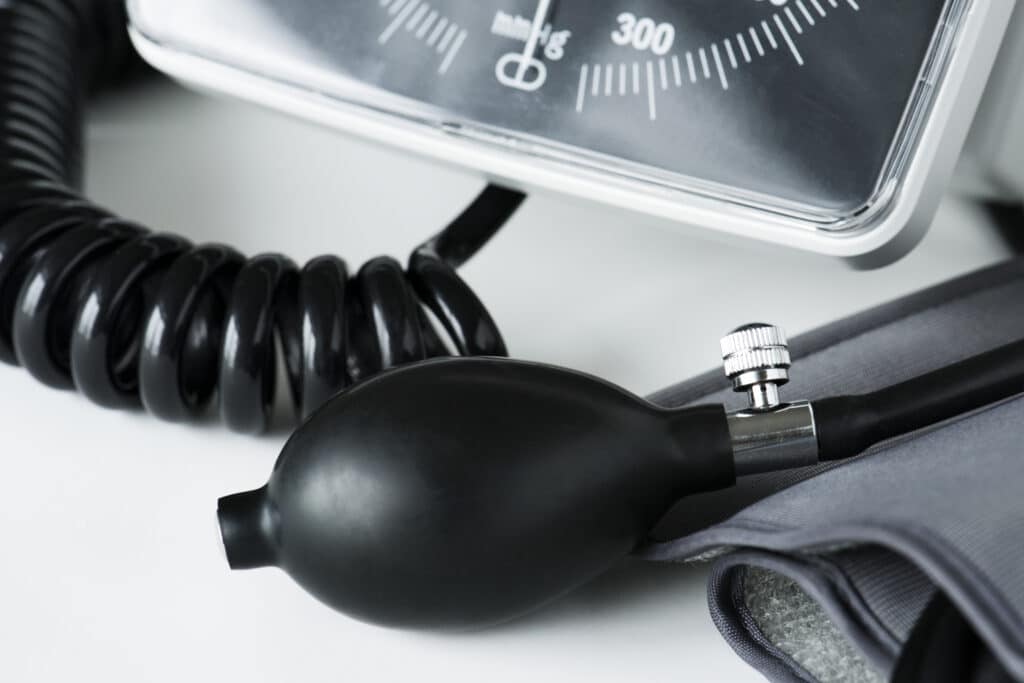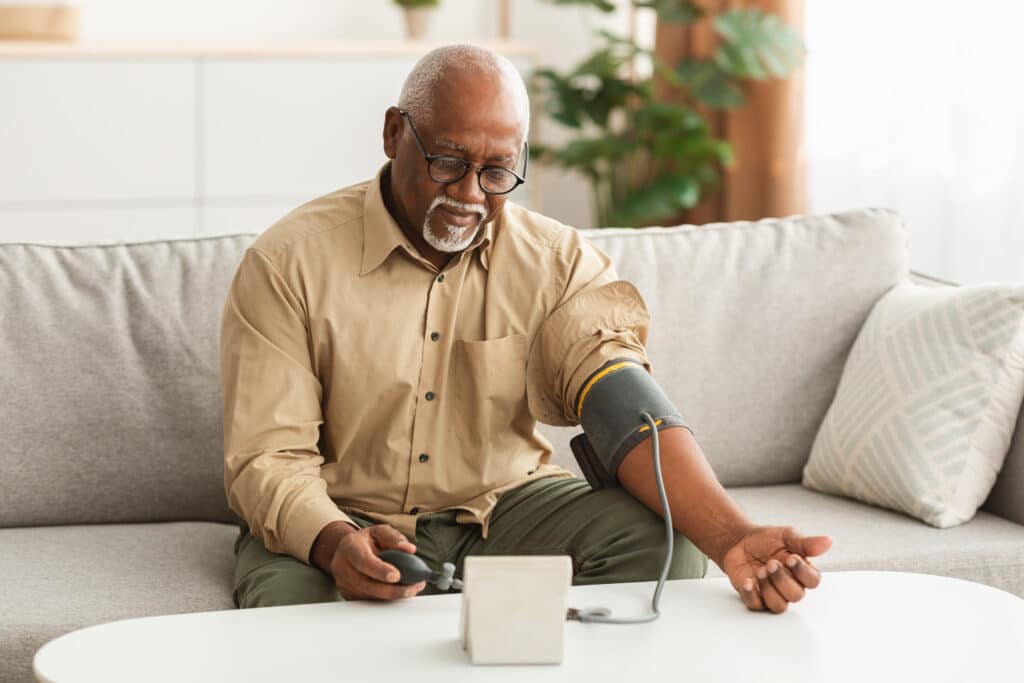Navigating the landscape of health and wellness as we age can feel like a complex puzzle. Understanding and managing our blood pressure is among the most critical pieces of this puzzle.
But what exactly is blood pressure, and why is it so crucial to our health? As a physical therapist who works with older adults of all backgrounds on managing their blood pressure, I’m eager to share these answers with you.
In this comprehensive guide, I’ll demystify blood pressure, explaining what it is, why it matters, and how to monitor it effectively at home. I’ll also delve into the causes of high blood pressure and share practical strategies for managing it.
I aim to empower you with the information you need to take charge of your heart health as you navigate your golden years. Let’s get started!
Understanding the Basics of Blood Pressure

In its simplest terms, blood pressure is the force of your blood pushing against the walls of your arteries. It’s like the water pressure in your home plumbing system, but we’re talking about your arteries instead of pipes. These vessels carry oxygen-rich blood from your heart to the rest of your body.
You may be wondering why blood pressure matters. Here’s how it works: Your heart needs a certain amount of pressure to deliver blood to the rest of your body efficiently. Too low, and you may feel dizzy or faint. Too high, and it can cause strain on your heart and arteries, leading to serious conditions like heart disease and stroke.1
Let’s put it in perspective with some numbers. The American Heart Association states that an ideal blood pressure reading is less than 120/80 mm Hg.2
The first number, systolic pressure, measures the force your blood exerts on artery walls when your heart beats. The second, called diastolic pressure, represents the force when your heart is at rest between beats.
Speaking from experience, most of my patients know what blood pressure is, but they need help understanding how it can impact their lives. More importantly, many people aren’t comfortable monitoring their blood pressure independently.
The Importance of Regular Blood Pressure Monitoring
Now that you know what blood pressure is, let’s dive into why keeping an eye on it is essential. Regular blood pressure checks are vital to maintaining your health as you age because they can help spot early signs of cardiovascular disease, the leading cause of death globally.3
High blood pressure, or hypertension, often has no symptoms. It’s been dubbed the “silent killer” for this reason. When you notice problems like chest pain or shortness of breath, it may indicate that a condition could be quite advanced.
This can be alarming, but the most critical takeaway is how much of your health you can control by knowing your blood pressure.
Because many older patients don’t keep track of their blood pressure regularly, I always measure my patients’ blood pressure during their first appointment.
Regular monitoring allows you to catch high blood pressure early. With lifestyle changes and, if necessary, medication, you can control hypertension and reduce your risk of heart disease and stroke. It’s a simple, non-invasive test that could save your life.
Making Reading Blood Pressure a Regular Habit
Blood pressure monitoring isn’t limited to visiting the doctor’s office. It plays a vital role in your fitness plan, too. Exercise is fantastic for your heart, but working out safely is essential. Monitoring your blood pressure can help ensure your heart isn’t under undue strain during physical activity.4
Measuring blood pressure before and after exercise can be a helpful way to learn how your body responds to exercise and identify potential problems related to exercise stress.
In a medical context, your healthcare provider uses your blood pressure readings and other tests and information to assess your overall health.
By spotting patterns and trends, they can make treatment decisions and help to manage conditions like diabetes and kidney disease.
With age, maintaining a healthy blood pressure becomes even more critical. Regular monitoring, combined with a balanced diet, exercise, and medication if needed, is a powerful defense against many age-related health concerns.
Regarding your health, knowledge is power — in this case, it could be lifesaving.
How to Measure Your Blood Pressure

No matter how you look at it, measuring blood pressure is vital to maintaining good health across your lifespan. But it may seem intimidating to beginners.
Here is a simple step-by-step guide to taking your blood pressure.
What You Need
Ready to take your blood pressure at home? Excellent! First, you’ll need a blood pressure monitor and a cuff.
Blood pressure monitors come in two types, manual and digital.
Manual monitors, sometimes called “aneroid” monitors, require a stethoscope to listen to the heartbeat. These are generally less expensive but are undoubtedly more complicated to use.
On the other hand, digital monitors are easier to read and use but can be more expensive. Having helped guide many patients in the process and monitoring my own for years, I always recommend a digital monitor.
Despite the cost, they avoid almost every challenge a manual monitor presents. Even better, modern digital blood pressure monitors don’t cost more than $50 in most cases.
Choosing the right cuff size is also essential. Too large, and your reading may be falsely low; too small, and it may be falsely high. The cuff should wrap snugly around your upper arm with enough room to slide two fingers underneath. Don’t worry; most monitors come with a cuff that fits most people.
How to Prepare
Preparation is critical when you’re taking your own blood pressure. Here are a few tips5:
- Rest for at least five minutes before taking your blood pressure.
- Avoid caffeine, alcohol, and tobacco for at least 30 minutes before taking your reading. These substances can temporarily raise your blood pressure.
- Don’t measure your blood pressure immediately after exercise, as readings can be temporarily high.
- Find a quiet, comfortable space to sit with your feet flat on the floor and your back supported.
I want to stress how important that last point is. Taking your blood pressure immediately after sitting down can give a drastically different reading than taking it after sitting quietly for five minutes.
How to Take a Reading
While manual monitors can be difficult, a blood pressure reading with a digital monitor is straightforward. Follow these steps to take a reading with a digital blood pressure monitor:
- Wrap the cuff around your upper arm, ensuring it’s snug but not tight.
- Position your arm so it’s at heart level. Support it with a cushion or armrest in front of you rather than holding it, which can skew your results.
- Press the “start” button on your monitor. It will inflate the cuff and start measuring your blood pressure.
- Once the reading is complete, the monitor deflates the cuff and displays your blood pressure reading.
The reading will show your systolic pressure (the top number, representing the pressure in your arteries when your heart beats) and your diastolic pressure (the bottom number, representing the pressure in your arteries between beats). An ideal blood pressure reading is less than 120/80 mmHg, but this can vary based on an extensive range of factors.
In many cases, taking multiple blood pressure readings in one sitting can be helpful. For example, after waiting five minutes and then taking your first blood pressure reading, wait at least one more minute and then take a second one. Once done, you can compare the two readings and take the average as your “true” blood pressure.
How Often to Track Blood Pressure
It’s generally recommended to measure your blood pressure at the same time each day, either daily or twice daily. This helps you see any trends or changes over time.
Remember, blood pressure can fluctuate throughout the day, and a single reading isn’t as important as the overall pattern of your blood pressure. Take your readings around the same time daily to get a broad idea of general trends. It’s also a good idea to rest for about five minutes before you take your daily reading.
Instead of being alarmed by a single high reading, notice if your readings are consistently high. If so, it’s probably time to speak with your healthcare provider.
By taking an active role in your health and monitoring your blood pressure at home, you can better manage your health and work proactively with your healthcare team.
Understanding Your Blood Pressure Readings
This is where things can get less black and white. In my experience working with older adults as a physical therapist, blood pressure can look very different between different people.
Remember, what matters most is paying attention to the big picture and working with your healthcare team to make the most of your heart health.
What Exactly is “Normal” Blood Pressure?
We know that your blood pressure is the force of your blood pushing against the walls of your arteries, and we refer to it using two numbers: systolic and diastolic pressures.
Systolic pressure is the force exerted on your artery walls when your heart beats. Diastolic pressure is the pressure when your heart is at rest between beats. So, if your blood pressure is 120/80, 120 is the systolic pressure, and 80 is the diastolic pressure.
The American Heart Association has established the following guidelines for adults:
- Normal: Less than 120/80 mm Hg
- Elevated: 120-129/<80 mm Hg
- High (hypertension stage 1): 130-139 or 80-89 mm Hg
- High (hypertension stage 2): 140 or higher or 90 mm Hg or higher2
To visualize this, imagine your arteries as garden hoses. Normal blood pressure is like a steady, moderate flow of water. High blood pressure, on the other hand, is like a forceful, rapid flow that can lead to irritation of the hose over time.
This is another reason why measuring your blood pressure multiple times throughout your day is so important. Some people have higher blood pressure at one point and lower blood pressure at another point. Still, the average of the two readings is actually less concerning.
Common Causes of High Blood Pressure
High blood pressure, or hypertension, can be caused by many different factors. Some we can control, like diet and lifestyle, while others, like genetics, are out of our hands.
Our lifestyle choices play a significant role in our blood pressure levels. For example, high salt (or sodium) and low potassium intake can increase blood pressure.6
Similarly, obesity and stress are also highly correlated to higher blood pressure readings. Imagine these things like water in a balloon; the more you add, the more pressure builds up.
However, many older adults have high blood pressure readings when they visit their doctor that don’t represent their blood pressure during everyday life. This is known as white coat hypertension, which describes blood pressure that increases because of stress or anxiety when visiting the doctor’s office.
Suppose I see a patient who seems otherwise healthy and has a slightly concerning blood pressure reading in the clinic. In that case, I ask patients to track their blood pressure at home to ensure white coat hypertension isn’t the cause of their elevated reading. Of course, if you’re unsure, always talk to your doctor for more help.
Lowering Your Blood Pressure: A Path to Improved Heart Health

So, how can older adults mitigate the risks of high blood pressure and lower readings?
Without a doubt, regular exercise, maintaining a healthy weight, and making dietary changes can all contribute to better blood pressure. For example, swapping processed foods for fresh fruits and vegetables can make a significant difference.
Let’s dig a little deeper into the role of diet in healthy blood pressure.
Dietary Cholesterol and the Impact of Poor Diet on Blood Pressure
The relationship between dietary cholesterol, poor diet, and blood pressure is significant for heart health. Consuming a diet high in bad cholesterol (LDL) and saturated fats can lead to the accumulation of plaque in the arteries, a condition known as atherosclerosis.
This buildup narrows the arteries, increasing the resistance against blood flow, which can subsequently elevate blood pressure levels.
Foods rich in saturated fats and trans fats—often found in processed foods, red meats, and full-fat dairy products—can contribute to higher levels of bad cholesterol in the blood. On the other hand, a diet poor in essential nutrients, fiber, and healthy fats can further exacerbate blood pressure issues.
A heart-healthy diet emphasizing fruits, vegetables, whole grains, lean proteins, and healthy fats (found in fish, nuts, and olive oil) can improve cholesterol levels and blood pressure.
Moreover, reducing the intake of sodium is critical in managing blood pressure. High sodium diets cause the body to retain water, increasing blood volume inside the blood vessels, thus raising blood pressure. Making dietary changes focusing on reducing bad cholesterol and sodium while increasing nutrient-dense foods can profoundly affect blood pressure and promote overall cardiovascular health.
Through mindful eating and informed dietary choices, individuals can significantly influence their heart health and mitigate the risks associated with high blood pressure.
The Impact of Cardiovascular Exercise on Heart Health and Blood Pressure
As a physical therapist, I always stress the importance of exercise for managing blood pressure.
Cardiovascular exercise is pivotal in promoting heart health and managing blood pressure. Regular cardiovascular activities such as brisk walking, cycling, and swimming can profoundly affect the cardiovascular system.
These exercises work by improving the efficiency of the heart’s ability to pump blood, which in turn reduces the force on the arteries and lowers blood pressure levels. Incorporating moderate-intensity cardiovascular exercise into their routine can especially benefit older adults.
Research shows that consistent cardiovascular exercise can significantly improve heart health, including increased heart muscle strength and improved blood circulation. These improvements can help reduce systolic and diastolic blood pressure readings to healthier levels.
Additionally, cardiovascular exercise aids in weight management and decreases the risk of developing other conditions associated with high blood pressure, such as heart disease and stroke. By making cardiovascular exercise a regular part of your lifestyle, you can take a proactive step towards lowering your blood pressure and enhancing your overall heart health.
In short, cardiovascular exercise is among the most critical tools for managing blood pressure.
Of course, relaxation techniques like deep breathing exercises, yoga, or meditation can also help manage stress levels, which can help lower blood pressure. Stress can be a significant contributor to high blood pressure, so combining stress management strategies with your exercise plan can be an excellent solution to control blood pressure without medication in some people.
Everyone is unique, and what works for one person might not work for another. Finding a blood pressure management method that works best for you is essential.
Remember, though, that while this guide can serve as a helpful starting point, it’s always best to seek advice from a healthcare professional for personalized guidance on managing your blood pressure.
As a physical therapist with extensive experience in helping older adults manage their blood pressure, I’ve crafted this guide to simplify the complexities of blood pressure management, emphasizing its crucial role in heart health. Through straightforward explanations and practical advice, I aim to empower you with the knowledge to monitor your blood pressure effectively at home and adopt lifestyle changes that can make a significant difference. By highlighting the importance of dietary choices, regular cardiovascular exercise, and consistent monitoring, this guide serves as a beacon for those navigating the journey toward improved heart health and longevity. Always remember that personalized guidance from healthcare professionals is invaluable in tailoring a plan that’s best for you.
Key Takeaways
Understanding and managing your blood pressure is essential to maintain a healthy heart and enjoy a longer life. With the right tools and knowledge, you can monitor your blood pressure and take control of your heart health. Here are some of the key points we’ve covered in this article:
- Blood pressure is the force of your blood against your artery walls, and it’s essential to keep it in check to prevent health complications like heart disease and stroke.
- Regular blood pressure monitoring can help spot early signs of potential issues, allowing for timely intervention and management.
- You can measure your blood pressure at home using a monitor and a cuff. Remember to follow the proper steps for an accurate reading.
- Various factors, including diet, lifestyle, and genetics, can cause high blood pressure. Regular exercise, a healthy diet, and stress management can help lower your blood pressure.
- A single reading isn’t as crucial as noticing patterns and trends over time. If your readings are consistently high, it’s time to contact your healthcare provider.
References
- High Blood Pressure. Mayo Clinic.
- Understanding Blood Pressure Readings. American Heart Association.
- The top 10 causes of death. World Health Organization.
- Mohammed LLM, Dhavale M, Abdelaal MK, Alam ABMN, Blazin T, Prajapati D, Mostafa JA. Exercise-Induced Hypertension in Healthy Individuals and Athletes: Is it an Alarming Sign? Cureus. 2020 Dec 9;12(12):e11988. doi: 10.7759/cureus.11988. PMID: 33437543; PMCID: PMC7793423.
- Monitoring Your Blood Pressure At Home. Heart.org
- Lower sodium could reduce blood pressure in most people. National Institutes of Health.




